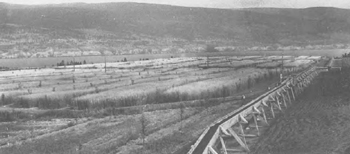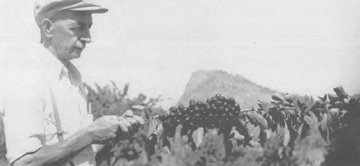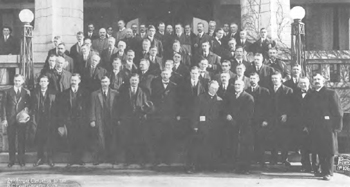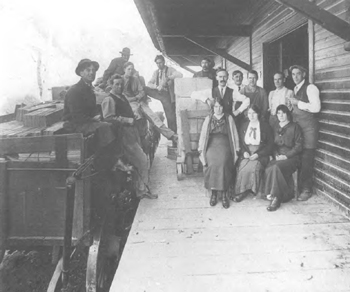News & Events More |
Marketing the CropGradually the marketing of Okanagan fruit became integrated into the complex North American system of produce distribution. That system had the vertical appearance of an hourglass, wide at the top and bottom but narrow in the middle, typifying the difficulty of the large numbers of growers in dealing on equal terms with the much smaller number of shippers, brokers, and jobbers who came between them and the ultimate consumers. In theory, the system as it operated on the Canadian Prairies, the chief and most profitable market for Okanagan fruit, worked thus: the fruit grower consigned, or sometimes sold, his fruit to the local shipper, who was also usually the packer. The shipper put this fruit in the hands of a broker, who arranged to sell it at the best possible price to the jobber or wholesaler. The broker then remitted the returns, less his costs and commission, to the shipper, who made a similar deduction and finally paid the grower. The jobber, meanwhile, sold the fruit to the retail outlets who supplied the eventual consumer. The neatness of the scheme was disrupted in reality by factors such as the interpenetration of one level of distribution by another. Many of the shippers owned large orchards, and themselves being grower-shippers, resisted cooperative efforts. The major jobbers were connected with, were owned by, or owned, grocery chains. By 1922 the major brokers were all connected in one way or another to jobber combines: "an attempt to join in one organization two opposing factorsthe broker, whose interest should be solely that of the grower; and the jobber, whose interest is opposed to that of the grower." As early as 1914, fruit growers were warned that "the combine and its methods [were] a serious menace to the successful marketing of Canadian fruit." Increasingly, the distribution system on the Prairies was monopolized at the jobber level by two massive organizations, the ever-expanding Americanowned Nash combine and an association of the remaining independent jobbers combined for self-protection. Vignette: Dominion Experimental Farm, SummerlandRepeated calls by the B.C.F.G.A., among other organizations, for an experimental farm in the "dry belt" area, finally resulted in the establishment of what is now known as the Summerland Research Station in late 1914, on about 162 hectares of land near Summerland. Despite the difficulties caused by the First World War, work proceeded on the experimental farm, whose main thrust was directed towards fruit growing, but which was also to study matters in all aspects of field and animal husbandry. The first season was taken up with breaking the land, constructing an irrigation system, and erecting buildings. Not until April 13, 1916, was the first fruit tree planted. 
Early operations were bedevilled by problems of water shortage, as local Summerland orchards had priority claim to the inadequate supply. For the first few years, "except for keeping the orchards alive, little was achieved horticulturally."1 In 1919 the Superintendant, R.H. Helmer, threatened to resign if adequate water was not available the next year. A diesel pump installed on the lakeshore in 1921 gave some relief to the lowest portions of the farm, but it was not until the Farm completed its own storage dam and supply system in 1925 that a regular supply of water could be assured. Early trials of fruit were aimed at testing the behavior of different varieties and at cultural questions such as pruning, thinning, fertilization, fruit quality, hardiness, and disease resistance. One of the earliest important discoveries was that the winterhardiness of fruit trees depended on soil moisture levels in the fall. 
In 1924 R.C. Palmer began the first apple breeding project, and began testing clonal rootstocks from East Mailing, England. Projects of importance to fruit growing over the years include breeding programs which have produced varieties such as the Spartan, Sinta, and Summerred apples, the Sam, Star, Van, Stella, and Lapins cherries, and the Skaha apricot. In 1935 several years of study determined that boron deficiency was the cause of drought spot-corky core, which halted a rapidly growing problem which threatened to put some Okanagan growers out of business. In more recent years work at the Station has been directed towards a wide range of horticultural concerns: codling moth eradication, storage of apples, development of fruit processing methods, and production of virus-free budwood in collaboration with the British Columbia Fruit Growers' Association, to mention just a sampling. The involvement of the Summerland Research Station in the Okanagan fruit industry has been so great that it is difficult to imagine one without the other. 

The idea of cooperation among fruit growers had continued to simmer since the turn of the century. The Okanagan Fruit Union was formed in 1908 and survived for several years. It was forced into liquidation by the sales disaster of 1912, the first of the periodic gluts on the market, when bumper crops in British Columbia and in the western United States coincided, and shippers forced prices to disastrous lows in their competition to dispose of their supplies. The poor returns affected all growers and resulted in widespread support for the idea of a cooperative able to stabilize the market. The Okanagan United Growers (OUG), made up of eight local packing associations and a central sales office, was formed in May, 1913, with the blessing of the provincial government, which lent it $155,200, eighty per cent of the required capital. In a campaign organized by a Vancouver broker, R.R. Robertson, who became first manager of the OUG, about 1100 growers were signed up, and for several years the cooperative functioned successfully. A Traffic and Credit Association, consisting of the Okanagan United Growers and the other principal shippers, was developed to discuss and agree on prices and shipping policy. Okanagan fruit production gradually expanded. The increased crop was sold on Prairie markets, where British Columbia's share of the apple market grew from 39% in 1915 to 82% in 1923. Contact Us Hours: 9am - 4pm weekdays. t: 250-762-5226 |

